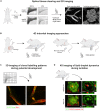Multidimensional Imaging of Mammary Gland Development: A Window Into Breast Form and Function
- PMID: 32296702
- PMCID: PMC7138012
- DOI: 10.3389/fcell.2020.00203
Multidimensional Imaging of Mammary Gland Development: A Window Into Breast Form and Function
Abstract
An in-depth appreciation of organ form and function relies on the ability to image intact tissues across multiple scales. Difficulties associated with imaging deep within organs, however, can preclude high-resolution multidimensional imaging of live and fixed tissues. This is particularly challenging in the mammary gland, where the epithelium lies deeply encased within a stromal matrix. Recent advances in deep-tissue and live imaging methodologies are increasingly facilitating the visualization of complex cellular structures within their native environment. Alongside, refinements in optical tissue clearing and immunostaining methods are enabling 3D fluorescence imaging of whole organs at unprecedented resolutions. Collectively, these methods are illuminating the dynamic biological processes underlying tissue morphogenesis, homeostasis, and disease. This review provides a snapshot of the current and state-of-the-art multidimensional imaging techniques applied to the postnatal mammary gland, illustrating how these approaches have revealed important new insights into mammary gland ductal development and lactation. Continual evolution of multidimensional image acquisition and analysis methods will undoubtedly offer further insights into mammary gland biology that promises to shed new light on the perturbations leading to breast cancer.
Keywords: 3D imaging; 4D imaging; breast cancer; intravital microscopy; lactation; mammary gland development; mammary stem cells.
Copyright © 2020 Lloyd-Lewis.
Figures

References
Publication types
LinkOut - more resources
Full Text Sources

